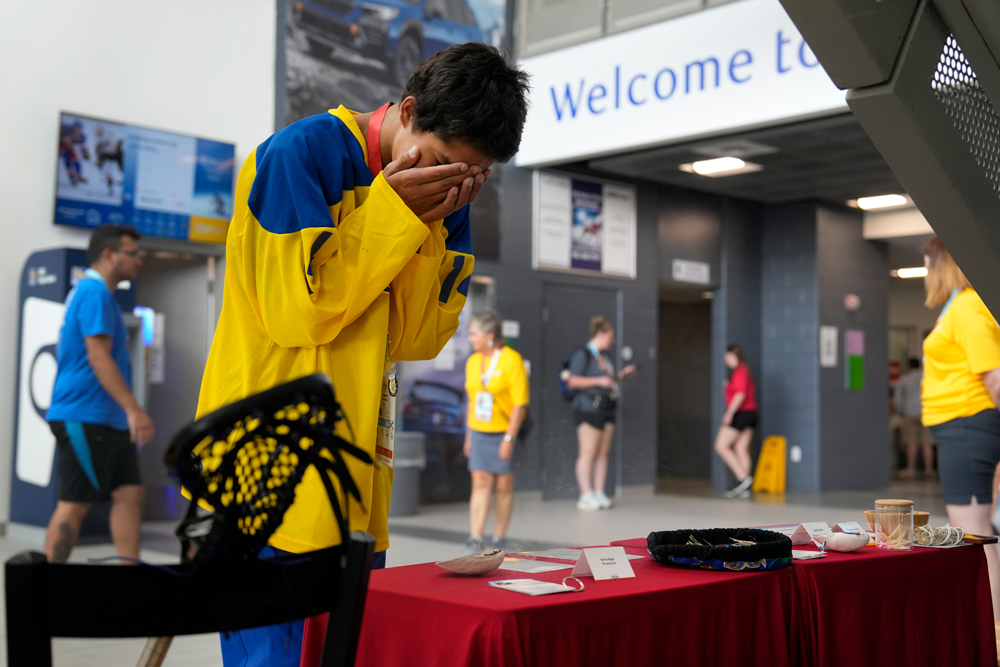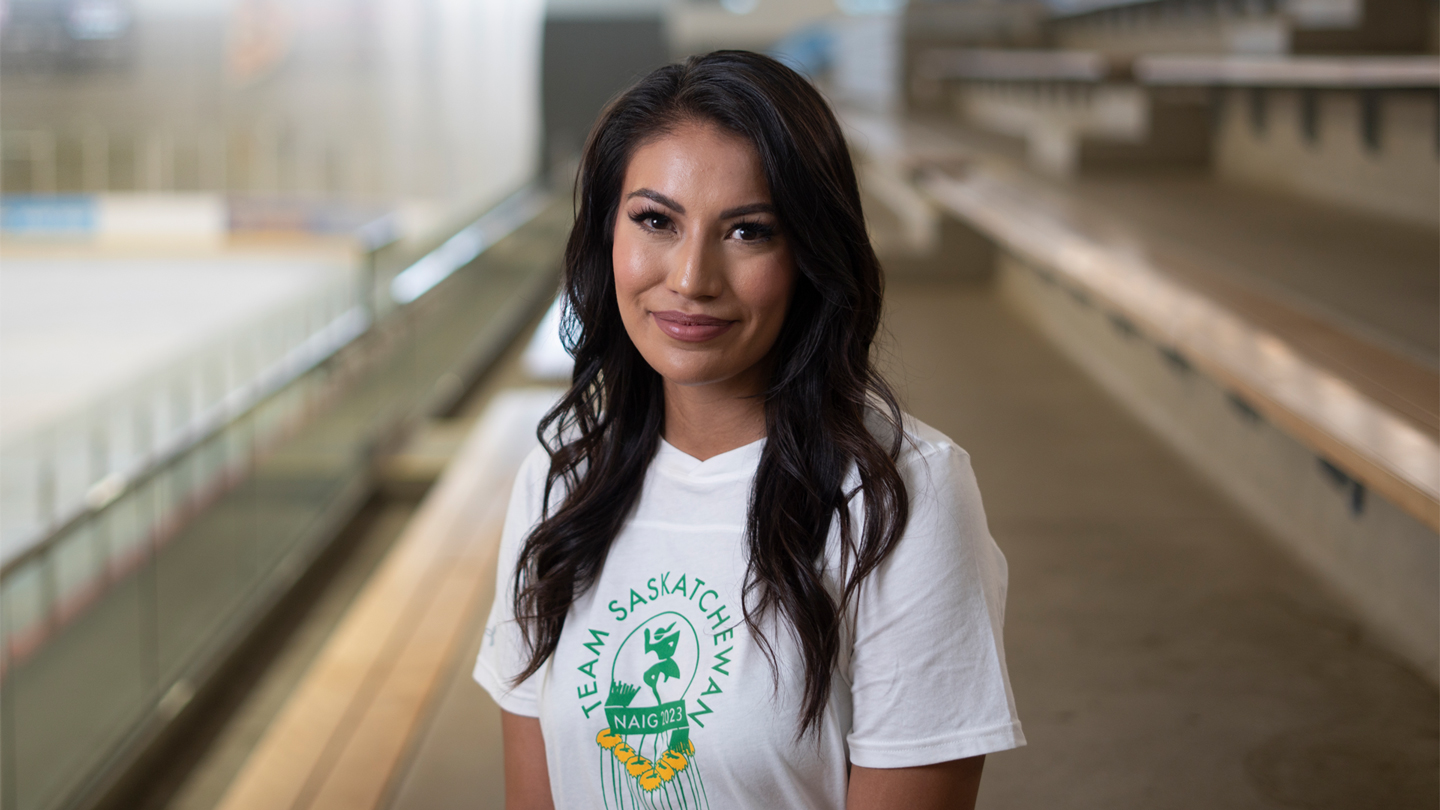THE SPIRIT OF THE GAMES

T he North American Indigenous Games is no typical event. Thousands of Indigenous youth, along with their families, coaches and friends, travel across North America to unite for something bigger than sport — a celebration of the immense importance of Indigenous youth taking up space in sports that also shines light on the support rallied behind these young athletes. NAIG is truly the pinnacle of excellence in Indigenous youth sports across the continent.
Family members have competed in the Games before, and I got a chance to watch them in Victoria in 1997. But I never got a chance to compete myself, so I didn’t know the event’s true impact. This year, though, I had the honour of being asked by Mark Arcand, the Tribal Chief of Saskatoon, to join the mission staff for Team Saskatchewan. My husband, Wacey Rabbit, and I volunteered our time by mentoring participants and conducting interviews with athletes, parents and coaches so families back home could feel closer to the action.
Before the Opening Ceremonies began, all the participants gathered in a large banquet hall — a first opportunity to get to know each other. I got to chat with athletes from all over North America and started pin trading — swapping commemorative enamel pins with members of other teams — which turned out to be quite the fun frenzy at NAIG. In those conversations, I could hear the pride in their voices, and that itself spoke volumes. I got a sense of immense joy and excitement, especially for the athletes who’d left their communities for the first time to attend. The positivity was infectious.


The Opening Ceremonies included a parade of nations, athletes, coaches and mission staff marching through the streets of downtown Halifax with flags, banners, and drums, and finishing at the Scotiabank Centre. Families and fans lined the sidewalks and cheered from balconies. I didn’t realize the magnitude of the games until the parade began. It felt like I was walking in an Olympic Opening Ceremony. As teams from all different provinces, states, territories and a few representing their tribal nations entered the arena, there was thunderous applause, cheers and chants.
The Games ran from mid- to late July and consisted of athletes in a variety of age categories competing across 16 different sports, including three traditional Indigenous sports: canoe/kayak, lacrosse and 3D archery. Competitions were open to the public and took place at 21 venues across Kjipuktuk (Halifax), Dartmouth, Millbrook First Nation and Sipekne’katik. As I traveled from event to event, I noticed many out of town license plates, and throughout the week, the city was booming with thrilled fans, parents cheering at every venue and newcomers to the Games who were genuinely excited to learn about Indigenous cultures. NAIG 2023 was the 10th installment of the games, which has been running since the 1970s and now welcomes over 756 Indigenous nations with more than 5,000 athletes, coaches and staff. There were also more than 3,000 volunteers who were enthusiastic to learn, educate and give direction to all those who were attending the games.
Throughout the week, I spoke to athletes about their goals and dreams and experiences in sports. Many said it was hard for them to dream big in the sports world at times because they didn’t feel accepted. They faced racism and felt the lack of Indigenous representation in different leagues and tournaments.



NAIG’s organizers made it their mission to create safe space and opportunities. The effect was palpable. Over the course of just a week, the youth grew to realize the importance of dreaming big, because those dreams seemed newly attainable. They’d been given new tools to envision them.
They gave me a new sense of what’s possible, too.
Wolfe Ross from Pelican Lake First Nation was a star performer at the games but almost didn’t get to compete due to an emergency health scare. This was Wolfe’s first trip away from his home community and had required him to travel by plane for the first time. He’d been afraid to travel alone, and when he arrived in Halifax, those fears seemed justified: he started to experience severe stomach pains and had to be admitted to hospital for appendicitis. To lift his spirits, his teammates held signs at the opening ceremonies that read “Get Well Wolfe.”
Wolfe’s dreams of competing in his first games were slipping away, but then a miracle happened and he was cleared to play after laying in a hospital bed for two days. The first thing he did was win gold in the U-14 javelin competition with a throw of more than 141 feet. After that, he won silver in discus with a throw that topped 80 feet. I spoke to Wolfe toward the end of the week and he said he was so happy he decided to come to the Games and overjoyed to bring his medals home to his family. He encouraged everyone to step out of their comfort zone because you never know where it might lead, right?
Miracles can happen, and sometimes the miracle is you.



The week went by fast, with numerous sports played nonstop at different locations around Halifax. The youth were thankful for Wacey and I taking the time to connect and get to know them. We were thankful to just to spend time with them. I made so many beautiful connections. Parents shared their stories of sacrifice and the pride they felt in their children. Coaches shared the importance of uplifting these competitors.
Athletes ranged in age from 13 to 19 years old, and as the Games progressed, I witnessed a profound change in them. I noticed they became more confident, stronger and more resilient, regardless of what was thrown their way, whether it was extreme heat or flooding or the rescheduling of games.
Parents and family members were similarly adaptable, always ready to watch, whether they were wearing shorts or ponchos. Many parents had a full circle moment, having themselves competed in past Games. The tears of joy and hugs of encouragement were beautiful, and the chants were so loud you could not only hear the support but feel it.
Allie Bear and Shayla Mike are prime examples of the parents that traveled and dedicated their time and support to their children. Allie and Shayla are proud mothers to U-19 silver medalists Karlee Bear from Ochapowace First Nation and Layne Mitsuing from Beardy’s First Nation. It was a whirlwind for Karlee and Layne, who’d both previously made the NAIG U-16 team for volleyball in 2020. Due to the pandemic, the girls had to wait and hope they didn’t age out before the Games returned. After another three long years, they got the chance to represent Saskatchewan in U-19 beach volleyball. After a back-and-forth game in the scorching heat, the girls won their silver. They had the biggest smiles on their faces after the match, looks that were mirrored on the faces of Allie and Shayla, who were lit with immense pride to see their daughters forge their own paths.



As the week drew to a close and I connected with youth who had been nervous, shy or scared when we first spoke, I asked them how they felt now that the Games were ending. They all told me how life-changing the experience had been and how important it is to step out of your comfort zone, and they were very eager to find out where the next Games will be held.
I traded more pins, made more memories with people who’d gone from complete strangers to friends that feel like family. This is the effect of the Games. This is what Spirit feels like. I left feeling like my heart was full, and I learned so much.
From the youth, I learned how to always be optimistic and work together as a team. From the parents, I learned the importance of unconditional support. And from the Games themselves, I learned how significant and life-changing a sporting event can be. Team Saskatchewan came away as the overall champs, but everyone there was a champion, regardless of placement.


In the Truth and Reconciliation Commission’s Calls to Action, there are five specific calls that outline how we can build a sporting system with a foundation of reconciliation and respect.
Call to Action 87 requires all levels of government to educate the public by sharing the individual and collective stories of Indigenous athletes to increase awareness and understanding of traditional Indigenous sports and games. Call to Action 88 calls on governments to ensure long-term growth and development opportunities for Indigenous athletes, and specifically calls for funding for the NAIG — both to host the Games and fund athletes’ travel and preparation costs. Call to Action 89 urges the federal government to ensure that any policy around sports and physical activity is inclusive of Indigenous peoples. Call to Action 90 urges the federal government to ensure that national sports policies, programs and initiatives are inclusive of Indigenous peoples and pushes for development and training programs for Indigenous athletes and coaches, community sports initiatives and anti-racism awareness and training. And Call to Action 91 calls for respect and engagement with Indigenous peoples and their communities’ territorial protocols by the officials, hosts and organizers of international sporting events like the Olympics and Pan Am Games.


I have a personal call of my own to add for my readers: If you have an opportunity in sports, remember to create opportunities for others as well. There is always more work to be done. Reconciliation requires us to take many steps forward together, and it’s important to remember every step counts. At this year’s NAIG, I saw and felt just how beautiful those steps can be.
The North American Indigenous Games is only held every four years, and I now understand why. There is so much work that goes into preparing, planning, training and bringing everyone together for an event that has so much meaning. The Games not only celebrate and highlight the talents of these Indigenous youth, but also underlines the support systems behind them.
As I gazed into the crowd of smiling faces, it was apparent to everyone that Indigenous people are still here, and we are rising. It’s more than just sport.

